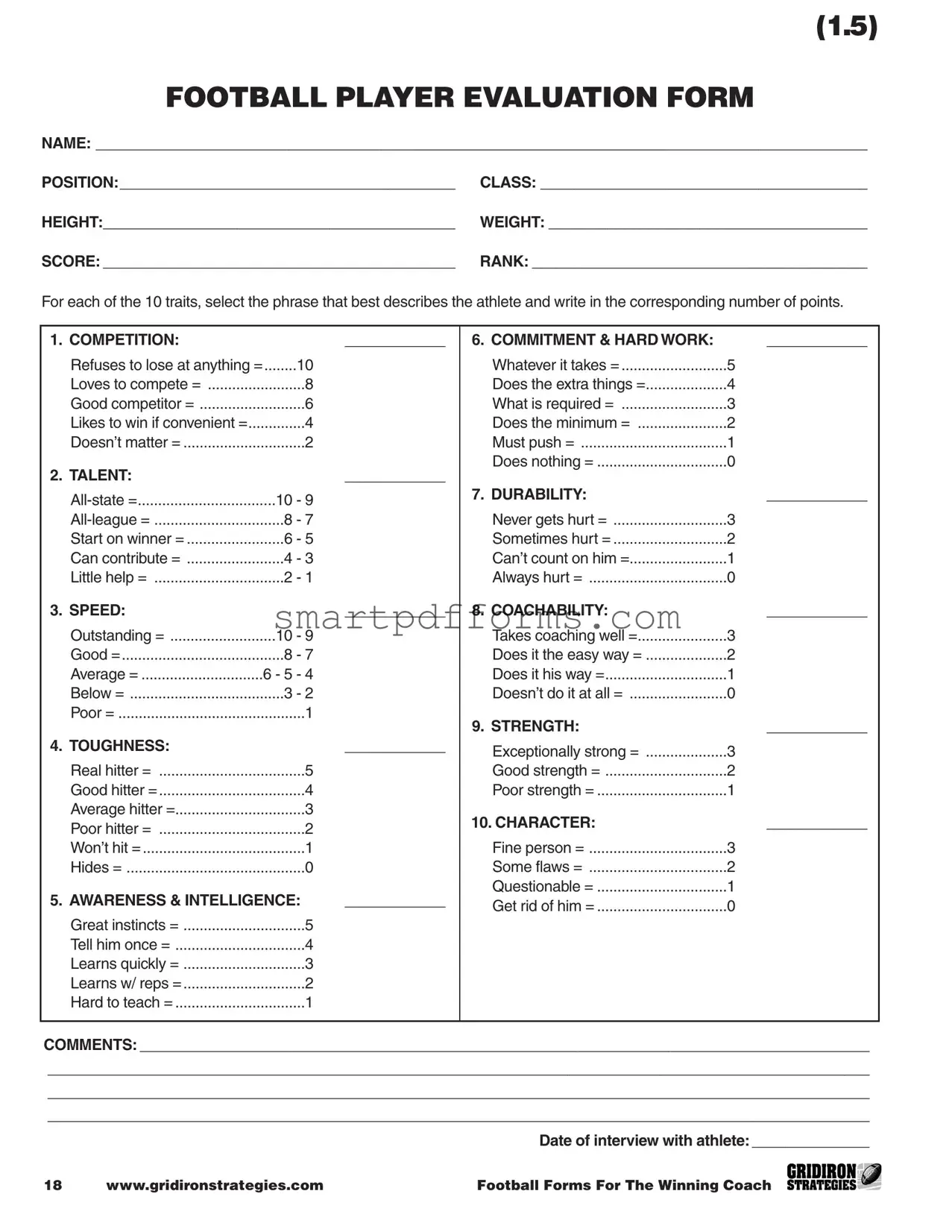- What is the purpose of the Football Player Evaluation Form?
The Football Player Evaluation Form is crafted to offer coaches a comprehensive tool to assess the abilities and aptitudes of football players across various dimensions pertinent to game play and team integration. This structured assessment enables the identification of strengths and areas for improvement, facilitating targeted training and development efforts. It encompasses an array of traits such as competition spirit, talent, speed, toughness, and several others that are critical for success in football.
- How should the form be filled out?
To accurately complete the form, evaluators should observe the athlete during games, practices, and other relevant contexts, comparing their performances against the criteria listed for each of the 10 traits. For each trait, the evaluator selects the descriptor that best represents the athlete’s abilities and records the corresponding number of points. The overall score and rank are then calculated based on the total points accumulated across all traits.
- Can this form be used for players at any level?
Absolutely. The Football Player Evaluation Form is versatile, making it suitable for evaluating players across a wide range of levels from youth leagues to college football. It is designed to be adaptable, accommodating the varying degrees of skill and competition encountered at different stages of football development.
- What does the 'SCORE' section refer to?
The 'SCORE' section is a numerical representation of the athlete's total performance across the evaluated traits. It is the aggregate of points assigned per trait, offering a quantifiable measure of the player’s overall ability and performance potential. This score serves as a comprehensive metric, aiding in comparative assessments among players.
- Can the form be adapted for specific team needs?
Indeed. While the Football Player Evaluation Form provides a solid foundation for assessing key player traits, coaches and teams are encouraged to adapt it to better align with specific priorities, strategies, and contexts. This might involve emphasizing particular traits over others or adding new criteria more closely reflective of the team’s unique needs and values.
- How is 'CHARACTER' evaluated within this form?
'CHARACTER' is assessed based on the player's personal qualities, sportsmanship, and overall demeanor, both on and off the field. This trait recognizes the importance of integrity, respect, and teamwork ethos in contributing to a positive team culture and performance. Evaluators assign a score reflecting their judgment of the player’s character, with a higher score corresponding to more commendable character traits.
- What should be done if a player disagrees with their evaluation?
It is essential for the evaluation process to remain transparent and constructive. Should a player contest their evaluation, a meeting should be arranged between the player, evaluator(s), and potentially a team representative or coach. During this meeting, the evaluation can be reviewed in detail, providing the player an opportunity to understand the perspectives taken and express their own viewpoint. This also opens the door for setting clear goals and actions for player improvement.
- Is it necessary to complete all sections of the form?
For a comprehensive evaluation, it is recommended to complete all sections of the form. Each trait is carefully chosen to cover a wide spectrum of abilities and characteristics significant for football players. However, if certain sections are not applicable or information is unavailable, it might be advisable to note this explicitly rather than leave the section blank, ensuring that the evaluation remains as informative as possible.
- How often should players be evaluated using this form?
The frequency of evaluations should align with the team’s objectives, the season’s phases, and individual player development needs. Initial evaluations may occur during preseason to establish benchmarks, followed by mid-season and post-season assessments to gauge progress. Adjustments to the frequency could be necessary based on specific circumstances or objectives, such as the introduction of new training programs or addressing identified areas for improvement.

